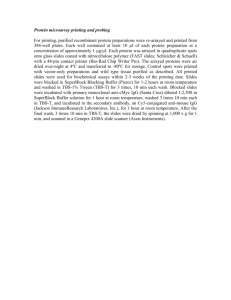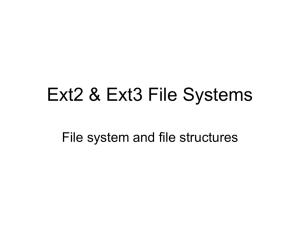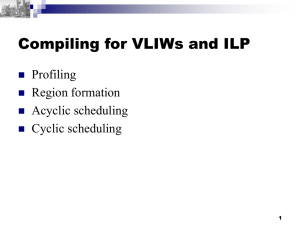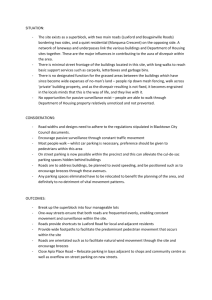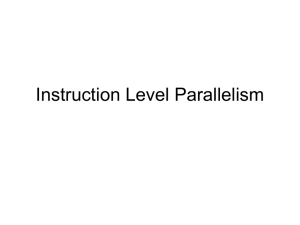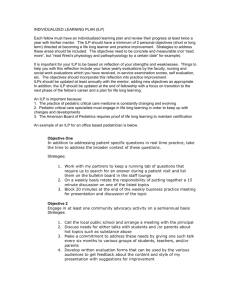The Journal of Supercomputing, 7, 229-248 (1993)
advertisement
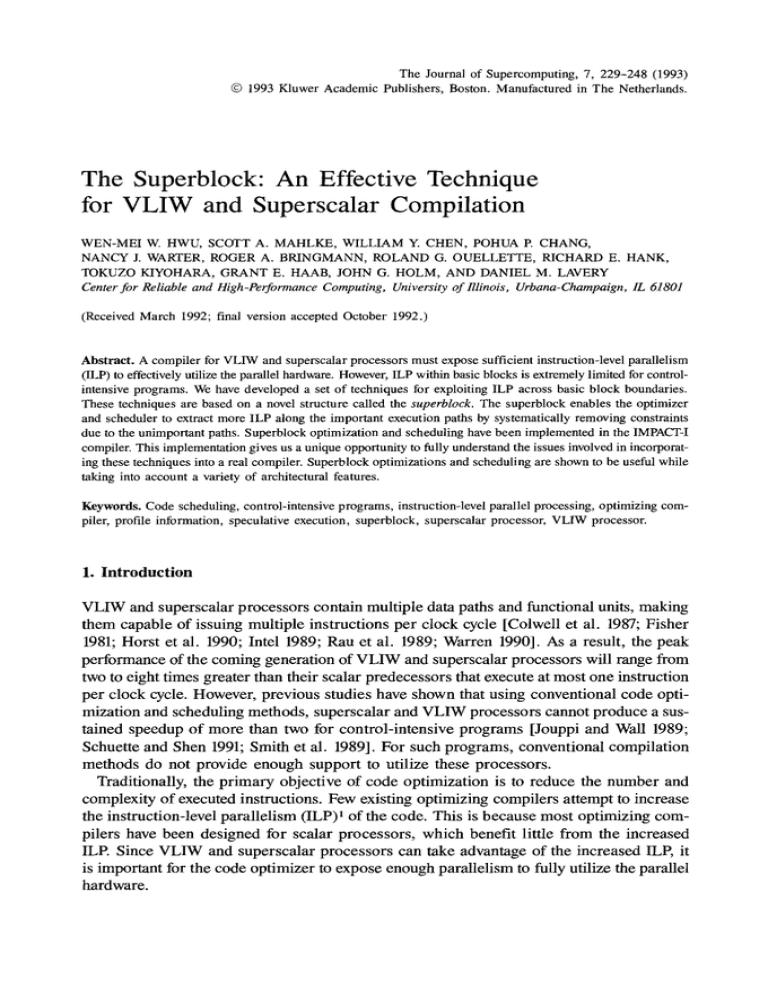
The Journal of Supercomputing, 7, 229-248 (1993)
9 1993 Kluwer Academic Publishers, Boston. Manufacturedin The Netherlands.
The Superblock: An Effective Technique
for VLIW and Superscalar Compilation
WEN-MEI W. HWU, SCOTT A. MAHLKE, WILLIAM Y. CHEN, POHUA P. CHANG,
NANCY J. WARTER, ROGER A. BRINGMANN, ROLAND G. OUELLETTE, RICHARD E. HANK,
TOKUZO KIYOHARA, GRANT E. HAAB, JOHN G. HOLM, AND DANIEL M. LAVERY
Centerfor Reliable and High-Performance Computing, University of lllinois, Urbana-Champaign, 1L 61801
(Received March 1992; final version accepted October 1992.)
Abstract. A compilerfor VLIW and superscalarprocessors must expose sufficientinstruction-levelparallelism
(ILP) to effectivelyutilizethe parallelhardware. However,ILP withinbasic blocks is extremelylimitedfor controlintensiveprograms. We have developed a set of techniques for exploitingILP across basic block boundaries.
These techniques are based on a novel structure called the superblock. The superblockenables the optimizer
and scheduler to extract more ILP along the importantexecutionpaths by systematicallyremovingconstraints
due to the unimportantpaths. Superblockoptimizationand schedulinghave been implementedin the IMPACT-I
compiler. This implementationgives us a uniqueopportunityto fully understandthe issuesinvolvedin incorporating these techniquesinto a real compiler. Superblockoptimizationsand schedulingare shownto be usefulwhile
taking into account a variety of architectural features.
Keywords. Code scheduling,control-intensiveprograms, instruction-levelparallel processing, optimizingcompiler, profile information, speculativeexecution, superblock, superscalarprocessor, VLIW processor.
1. Introduction
VLIW and superscalar processors contain multiple data paths and functional units, making
them capable of issuing multiple instructions per clock cycle [Colwell et al. 1987; Fisher
1981; Horst et al. 1990; Intel 1989; Rau et al. 1989; Warren 1990]. As a result, the peak
performance of the coming generation of VL1W and superscalar processors will range from
two to eight times greater than their scalar predecessors that execute at most one instruction
per clock cycle. However, previous studies have shown that using conventional code optimization and scheduling methods, superscalar and VLIW processors cannot produce a sustained speedup of more than two for control-intensive programs [Jouppi and Wall 1989;
Schuette and Shen 1991; Smith et al. 1989]. For such programs, conventional compilation
methods do not provide enough support to utilize these processors.
Traditionally, the primary objective of code optimization is to reduce the number and
complexity of executed instructions. Few existing optimizing compilers attempt to increase
the instruction-level parallelism (ILP) 1 of the code. This is because most optimizing compilers have been designed for scalar processors, which benefit little from the increased
ILP. Since VLIW and superscalar processors can take advantage of the increased ILP, it
is important for the code optimizer to expose enough parallelism to fully utilize the parallel
hardware.
230
w.w. HWU ET AL.
The amount of ILP within basic blocks is extremely limited for control-intensive programs. Therefore, the code optimizer must look beyond basic blocks to find sufficient ILP.
We have developed a set of optimizations to increase ILP across basic block boundaries.
These optimizations are based on a novel structure called the superblock. The formation
and optimization of superblocks increase the ILP along the important execution paths by
systematically removing constraints due to the unimportant paths. Becauase these optimizations increase the ILP within superblocks, they are collectively referred to as superblock
ILP optimizations.
Unlike code optimization, code scheduling for VLIW processors has received extensive
treatment in the literature [Aiken and Nicolau 1988; Bernstein and Rodeh 1991; Ellis 1986;
Fisher 1981; Gupta and Sofia 1990]. In particular, the trace scheduling technique invented
by Fisher [1981] has been shown to be very effective for rearranging instructions across
basic blocks. An important issue for trace scheduling is the compiler implementation complexity incurred by the need to maintain correct program execution after moving instructions across basic blocks. The code scheduling technique described in this paper, which
is derived from trace scheduling, employs the superblock. Superblock ILP optimizations
remove constraints, and the code scheduler implementation complexity is reduced. This
code scheduling approach will be referred to as superblock scheduling.
In order to characterize the cost and effectiveness of the superblock ILP optimizations
and superblock scheduling, we have implemented these techniques in the IMPACT-I compiler developed at the University of Illinois. The fundamental premise of this project is
to provide a complete compiler implementation that allows us to quantify the impact of
these techniques on the performance of VLIW and superscalar processors by compiling
and executing large control-intensive programs. In addition, this compiler allows us to fully
understand the issues involved in incorporating these optimizations and scheduling techniques into a real compiler. Superblock optimizations are shown to be useful while taking
into account a variety of architectural parameters.
Section 2 of this paper introduces the superblock. Section 3 gives a concise overview
of the superblock ILP optimizations and superblock scheduling. Section 4 presents the cost
and performance of these techniques. The concluding remarks are made in Section 5.
2. The Superblock
The purpose of code optimization and scheduling is to minimize execution time while preserving program semantics. When this is done globally, some optimization and scheduling
decisions may decrease the execution time for one control path while increasing the time
for another path. By making these decisions in favor of the more frequently executed path,
an overall performance improvement can be achieved.
Trace scheduling is a technique that was developed to allow scheduling decisions to be
made in this manner [Ellis 1986; Fisher 19811. In trace scheduling the function is divided
into a set of traces that represent the frequently executed paths. There may be conditional
branches out of the middle of the trace (side exits) and transitions from other traces into
the middle of the trace (side entrances). Instructions are scheduled within each trace ignoring these control-flow transitions. After scheduling, bookkeeping is required to ensure the
correct execution of off-trace code.
THE SUPERBLOCK
231
Code motion past side exits can be handled in a fairly straightforward manner. If an
instruction I is moved from above to below a side exit, and the destination of I is used
before it is redefined when the side exit is taken, then a copy of I must also be placed
between the side exit and its target. Movement of an instruction from below to above a
branch can also be handled without too much difficulty. The method for doing this is described in Section 3.4.
More complex bookkeeping must be done when code is moved above and below side
entrances. Figure 1 illustrates this bookkeeping. In Figure la, when Instr I is moved below
the side entrance (after Instr 4), the side entrance is moved below Instr 1. Instr 3 and Instr 4
are then copied to the side entrance. Likewise, in Figure lb, when Instr 5 is moved above
the side entrance, it must also be copied to the side entrance.
Side entrances can also make it more complex to apply optimizations to traces. For example, Figure 2 shows how copy propagation can be applied to the trace and the necessary
bookkeeping for the off-trace code. In this example, in order to propagate the value of rl
from I1 to 13, bookkeeping must be performed. Before we propagate the value of rl, the
side entrance is moved below 13 and instructions 12 and 13 are copied to the side entrance.
The bookkeeping associated with side entrances can be avoided if the side entrances are
removed from the trace. A superblock is a trace that has no side entrances. Control may
only enter from the top but may leave at one or more exit points. Superblocks are formed
in two steps. First, traces are identified using execution profile information [Chang and
Hwu 1988]. Second, a process called tail duplication is performed to eliminate any side
entrances to the trace [Chang, Mahlke, and Hwu 1991]. A copy is made of the tail portion
of the trace from the first side entrance to the end. All side entrances into the trace are
then moved to the corresponding duplicate basic blocks. The basic blocks in a superblock
need not be consecutive in the code. However, our implementation restructures the code
so that all blocks in a superblock appear in consecutive order for better cache performance.
The formation of superblocks is illustrated in Figure 3. Figure 3a shows a weighted flow
graph that represents a loop code segment. The nodes correspond to basic blocks, and
the arcs correspond to possible control transfers. The count of each block indicates the
execution frequency of that basic block. In Figure 3a the count of {A, B, C, D, E, F} is
/,
N
Figure 1. Instructionscheduling across trace side entrances: (a) movingan instruction below a side entrance;
(b) movingan instruction above a side entrance.
232
w.w. HWU ET AL.
t
r l <- 64
rl <- 64'
If:
rl <-4
I2s
1"2<-
I31
r3 <- m e m ( r 2 + r l )
Ii:
]
1
l~,~,.,,, J
rl <-4
~.,
r2 <- label(_A)
label(A)
13:
(a)
r3 <- mem(r2+4)
(bl
Figure 2. Applying copy propagation to an instruction trace: (a) before copy propagation; (b) after copy propagation with bookkeeping code inserted.
9
...........i
1o
!
.....................
Q
(a)
(b)
Figure 3. An example of superblock formation: (a) after trace selection; (b) after tail duplication.
THE SUPERBLOCK
233
{100, 90, 10, 0, 90, 100}, respectively The count of each control transfer indicates the frequency of invoking these control transfers. In Figure 3a the count of {A ~ B, A ~ C,
B ~ D, B ~ E , C ~ F, D ~ F, E ~ F, F ~ A } is {90, 10, 0, 90, 10, 0, 90, 99}, respectively. Clearly, the most frequently executed path in this example is the basic block sequence
<A, B, E, F). There are three traces: {A, B, E, F}, {C}, and {D}. After trace selection,
each trace is converted into a superblock. In Figure 3a we see that there are two control
paths that enter the {A, B, E, F} trace at basic block E Therefore, we duplicate the tail
part of the {A, B, E, F} trace starting at basic block E Each duplicated basic block forms
a new superblock that is appended to the end of the function. The result is shown in Figure
3b. Note that there are no longer side entrances into the most frequently traversed trace,
<A, B, E, F); it has become a superblock.
Superblocks are similar to the extended basic blocks. An extended basic block is defined
as a sequence of basic blocks B 1 . . . B~ such that for 1 < i < k, B i is the only predecessor
of Bi+1 and B1 does not have a unique predecessor [Aho et al. 1986]. The difference between superblocks and extended basic blocks lies mainly in how they are formed. Superblock
formation is guided by profile information, and side entrances are removed to increase
the size of the superblocks. It is possible for the first basic block in a superblock to have
a unique predecessor.
3. Superblock ILP Optimization and Scheduling
Before superblock scheduling is performed, superblock ILP optimizations are applied which
enlarge the superblock and increase instruction parallelism by removing dependences.
3.1. Superblock Enlarging Optimizations
The first category of superblock ILP optimizations is superblock enlarging optimizations.
The purpose of these optimizations is to increase the size of the most frequently executed
superblocks so that the superblock scheduler can manipulate a larger number of instructions. It is more likely the scheduler will find independent instructions to schedule at every
cycle in a superblock when there are more instructions to choose from. An important feature
of superblock enlarging optimizations is that only the most frequently executed parts of
a program are enlarged. This selective enlarging strategy keeps the overall code expansion
under control [Chang, Mahlke, and Hwu 1991]. Three superblock enlarging optimizations
are described as follows.
1. Branch target expansion. Branch target expansion expands the target superblock of a
likely-taken control transfer that ends a superblock. The target superblock is copied and
appended to the end of the original superblock. Note that branch target expansion is
not applied for control transfers that are loop back edges. Branch target expansion continues to increase the size of a superblock until a predefined superblock size is reached
or the branch ending the superblock does not favor one direction.
2. Loop peeling. Superblock loop peeling modifies a superblock loop (a superblock that
ends with a likely control transfer to itself) that tends to iterate only a few times for
234
w.w. HWU ET AL.
each loop execution. The loop body is replaced by straight-line code consisting of the
first several iterations of the loop.2 The original loop body is moved to the end of the
function to handle executions that require additional iterations. After loop peeling, the
most frequently executed preceding and succeeding superblocks can be expanded into
the peeled loop body to create a single large superblock.
3. Loop unrolling. Superblock loop unrolling replicates the body of a superblock loop that
tends to iterate many times. To unroll a superblock loop N times, N - 1 copies of the
superblock are appended to the original superblock. The loop back-edge control transfers
in the first N - 1 loop bodies are adjusted or removed if possible to account for the
unrolling. If the iteration count is known on loop entry, it is possible to remove these
transfers by using a preconditioning loop to execute the first rnod N iterations. However,
preconditioning loops are not currently inserted for unrolled loops.
3.2. Superblock Dependence-Removing Optimizations
The second category of superblock ILP optimizations is superblock dependence-removing
optimizations. These optimizations eliminate data dependences between instructions within
frequently executed superblocks, which increases the ILP available to the code scheduler.
As a side effect some of these optimizations increase the number of executed instructions.
However, by applying these optirnizations only to frequently executed superblocks, the code
expansion incurred is regulated. Five superblock dependence-removing optimizations are
described as follows:
1. Register renaming. Reuse of registers by the compiler and variables by the programmer
introduces artificial antidependences and output dependences and restricts the effectiveness of the scheduler. Many of these artificial dependences can be eliminated with register
renaming [Kuck et al. 1981]. Register renaming assigns unique registers to different definitions of the same register and is commonly used to rename registers within individual
loop bodies of an unrolled superblock loop.
2. Operation migration. Operation migration moves an instruction from a superblock where
its result is not used to a less frequently executed superblock. By migrating an instruction, all of the data dependences associated with that instruction are eliminated from
the original superblock. Operation migration is performed by detecting an instruction
whose destination is not referenced in its home superblock. Based on a cost constraint
a copy of the instruction is placed at the target of each exit of the superblock in which
the destination of the instruction is live. Finally, the original instruction is deleted.
3. Induction variable expansion. Induction variables are used within loops to index through
loop iterations and through regular data structures such as arrays. When data access
is delayed due to dependences on induction variable computation, ILP is typically limited.
Induction variable expansion eliminates redefinitions of induction variables within an
unrolled superblock loop. Each definition of the induction variable is given a new induction variable, thereby eliminating all antidependences and output and flow dependences
among the induction variable definitions. However, an additional instruction is inserted
into the loop preheader to initialize each newly created induction variable. Also, patch
THE SUPERBLOCK
235
code is inserted if the induction variable is used outside the superblock to recover the
proper value for the induction variable.
4. Accumulator variable expansion. An accumulator variable accumulates a sum or product
in each iteration of a loop. For loops of this type the accumulation operation often defmes
the critical path within the loop. Similar to induction variable expansion, antidependences
and output and flow dependences between instructions that accumulate a total are eliminated by replacing each definition of an accumulator variable with a new accumulator
variable. Unlike induction variable expansion, though, the increment or decrement value
is not required to be constant within the superblock loop. Again, initialization instructions for these new accumulator variables must be inserted into the superblock preheader.
Also, the new accumulator variables are summed at all superblock exit points to recover
the value of the original accumulator variable. Note that accumulator variable expansion
applied to floating point variables may not be safe for programs that rely on the order
in which arithmetic operations are performed to maintain accuracy. For programs of
this type an option is provided for the user to disable the accumulator variable expansion of floating point variables.
5. Operation combining. Flow dependences between pairs of instructions with the same
precedence, each with a compile-time constant source operand, can be eliminated with
operation combining [Nakatani and Ebcioglu 1989]. Flow dependences that can be eliminated with operation combining often arise between address calculation instructions
and memory access instructions. Also, similar opportunities occur for loop variable
increments and loop exit branches. The flow dependence is removed by substituting
the expression of the first instruction into the second instruction and evaluating the constants at compile time.
An example to illustrate loop unrolling, register renaming, induction variable expansion,
and accumulator variable expansion is shown in Figure 4. This example assumes that the
condition of the if statement within the loop is likely to be true. The resulting assembly
code after superblock formation is shown in Figure 4b. To enlarge the superblock loop,
loop unrolling is applied. The loop is unrolled three times in this example (Figure 4c).
After loop unrolling, data dependences limit the amount of ILP in the superblock loop.
The dependences among successive updates of r4 (Figure 4c) are eliminated with accumulator variable expansion. In Figure 4d three temporary accumulators, r 14, r24, and r34,
are created within the superblock loop. After accumulator expansion, all updates to r4
within one iteration of the unrolled loop are independent of one another. In order to maintain correctness the temporary accumulators are properly initialized in the loop preheader
(pre), and the values are summed at the loop exit point (L2). The dependences among
the successive updates of r 1, along with the updates of r 1 and the succeeding load instructions (Figure 4c), are eliminated with induction variable expansion. In Figure 4d three
temporary induction variables, rl 1, r21, and r31, are created within the superblock loop.
After induction variable expansion the chain of dependences created by the induction variable
is eliminated within one iteration of the unrolled loop. Finally, register renaming is applied
to the load instructions to eliminate output dependences. After all superblock ILP optimizations are applied, the execution of the original loop bodies within the unrolled superblock
loop may be completely overlapped by the scheduler.
236
W.W. HWU ET AL.
(d)
pre
L1
Original
Loop
(c)
(a)
L1
if (A[i] == i] C += B[i]
i++
if (i < N) g o t o L1
L1
r2
= MEM(A + rl)
bne Jr2 i) L3
l
r3 = M E M ( B + rl)i
L2
J
r4 = r4 + r3
rl = rl + 4
(b)
L1
r2
= MEM(A
bne
r3
(r2 i) L3
- M E M ( B + rl)
r4
rl
= r4
= rl
blt
+ rl)
f
+ r3
+ 4
(rl N')
bge
Unroll
bge
Dependence
Removal
L2
= M E M ( A + rl)
bne (r2 i) L3
r3 = M E M ( B + rl)
L2
r4 = r4 + r3
rl = rl + 4
b l t (rl N') L1
B2
L3
L2
LI3
:
- rl
= rl
= r4
r24
r34
= 0
= 0
r12
bne
- MEM(A
(rl2 I)
r13
r14
= M E M ( B * rll)
= r14 § r13
I
: I rl = rl + 4
b l t (rl N') L1
g o t o L2
+ 4
+ 8
+ rll)
LI3
bge
(r21 N')
r22
bne
r23
- M E M ( A + r21)
(r22 i) L 2 3
= M E M ( B + r21)
r24
= r24 + r23
(r31 N') L2
r32
r2
rl = rl + 4
b l t Irl N'] L1
goto
(rl N')
= rl
r21
r31
r14
bge
+ rl)
L3
+ rl)
r4 = r4 + r3
rl = rl + 4
Loop
L1
(rl N' ) L2
r2 = M E M ( A
bne (r2 I)
r3 = M E M ( B
rll
L2
bne
= MEM(A
(r32 I)
r33
r34
= M E M ( B + r31)
= r34 + r33
+ r31)
L33
rll
r21
= rll
= r21
r31
blt
= r 3 1 + 12
(rll N') L1
+ 12
+ 12
r4 = r14 + r24
r4 = r4 + r34
~////////////////////////~
rll
= rll
+ 4
r21
r31
= r21
= r31
+ 4
+ 4
b l t (rll N')
oto L2
I
L23
rll
r21
= rll
= r21
r31
blt
= r31 + 8
(rll N') L 1
oto
L33
L1
+ 8
+ 8
L2
rll
= rll
+ 12
r21
r31
= r21
= r31
+ 12
+ 12
b l t (rll N')
g o t o L2
L1
Figure 4. An application of superblock ILP optimizations: (a) original program segment; (b) assembly code after
superblock formation; (c) assembly code after superblock loop unrolling; (d) assembly code after superblock
dependence-removal optimizations.
3.3. Superblock Scheduling
After the superblock ILP optimizations are applied, superblock scheduling is performed.
Code scheduling within a superblock consists of two steps: dependence graph construction
tbllowed by list scheduling. A dependence graph is a data structure that represents the Control and data dependences between instructions. A control dependence is initially assigned
between each instruction and every preceding branch in the superblock. Some control dependences may then be removed according to the available hardware support described
in the following section. After the appropriate control dependences have been eliminated,
list scheduling using the dependence graph, instruction latencies, and resource constraints
is performed on the superblock.
THE SUPERBLOCK
237
3.4. Speculative Execution Support
Speculative execution refers to the execution of an instruction before it is known that its
execution is required. Such an instruction will be referred to as a speculative instruction.
Speculative execution occurs when the superblock scheduler moves an instruction J above
a preceding conditional branch B. During run time J will be executed before B; that is,
J is executed regardless of the branch direction of B. However, according to the original
program order, J should be executed only if B is not taken.3 Therefore, the execution result
of J must not be used if B is taken, which is formally stated as follows:
Restriction 1. The destination of J is not used before it is redefined when B is taken.
This restriction usually has very little effect on code scheduling after superblock ILP
optimization. For example, in Figure 4d after dependence removal in block L/, the instruction that loads B [i] into r 13 can be executed before the direction of the preceding bne instruction is known. Note that the execution result of this load instruction must not be used
if the branch is taken. This is trivial to do because r 13 is never used before it has been
defined if the branch is taken; the value thus loaded into r13 will be ignored in the subsequent execution.
A more serious problem with speculative execution is the prevention of premature program termination due to exceptions caused by speculative instructions. Exceptions caused
by speculative instructions that would not have executed on a sequential machine must be
ignored, which leads to the following restriction:
Restriction 2. J will never cause an exception that may terminate program execution when
branch B is taken.
In Figure 4d the execution of the instruction that loads B [i] into r 13 could potentially
cause a memory-access violation fault. If this instruction is speculatively scheduled before
its preceding branch and such a fault occurs during execution, the exception should be
ignored if the branch was taken. Reporting the exception if the branch is taken would have
incorrectly terminated the execution of the program.
Two levels of hardware support for Restriction 2 will be examined in this paper: the
restricted percolation model and the generalpercolation model. The restricted percolation
model includes no support for disregarding the exceptions generated by the speculative
instructions. For conventional processors, memory load, memory store, integer divide,
and all floating point instructions can cause exceptions. When using the restricted percolation model, these instructions may not be moved above branches unless the compiler can
prove that those instructions can never cause an exception when the preceding branch is
taken. The limiting factor of the restricted percolation model is the inability to move potential
trap-causing instructions with long latency, such as load instructions, above branches. When
the critical path of a superblock contains many of these instructions, the performance of
the restricted percolation model is limited.
The general percolation model eliminates Restriction 2 by providing a nontrapping version of instructions that can cause exceptions [Chang et al. 1991]. Exceptions that may
terminate program execution are avoided by converting all speculative instructions that can
potentially cause exceptions into their nontrapping versions. For programs in which detection of exceptions is important, the loss of exceptions can be recovered with additional
architectural and compiler support [Mahlke et al. 1992]. However, in this paper only the
238
w.w. HWU ET AL.
nontrapping execution support is used. In Section 4.5 we will show how the general percolation model allows the superblock scheduler to exploit much more of the ILP exposed
by superblock ILP optimizations than the restricted percolation model.
4. Implementation Cost and Performance Results
In this section we report the implications of superblock ILP optimization and scheduling
on compiler size, compile time, and output code performance. We also examine three architectural factors that directly affect the effectiveness of superblock ILP optimizations and
scheduling: speculative execution support, instruction cache misses, and data cache misses.
4.1. Compiler Size
The IMPACT-I C compiler serves two important purposes. First, it is intended to generate
highly optimized code for existing commercial microprocessors. We have constructed code
generators for the MIPS R2000, SPARC, Am29000, i860, and HP PA-RISC processors.
Second, it provides a platform for studying new code optimization techniques for instructionlevel parallel processing. New code optimization techniques, once validated, can be immediately applied to the VLIW and superscalar implementations of existing and new commercial architectures.
Figure 5 shows the percentage of compiler size due to each level of compiler sophistication. The base level accounts for the C front end, traditional code optimizations, graphcoloring-based register allocation, basic block scheduling, and one code generator [Chaitin
1982; Chow and Hennessy 1990]. The traditional optimizations include classical local and
global code optimizations, function in-line expansion, instruction placement optimization,
profile-based branch prediction, and constant preloading [Aho et al. 1986; Hwu and Chang
1989a; Hwu and Chang 1989b]. The profile level generates dynamic execution frequency
information and feeds this information back to the compiler. The superblock formation
level performs trace selection, tail duplication, and superblock scheduling. The superblock
82*/,
9 Base
[] Profile
[] SuperblockFormation
[] SuperblockOptimization
120
20/* 4%
Figure 5. Compilercode size breakdown.The entirecompilerconsists of approximately92,000 lines of C code
with one code generator.
THE SUPERBLOCK
239
ILP optimization level performs branch expansion, loop unrolling, loop peeling, register
renaming, induction variable expansion, accumulator expansion, operation migration, and
operation combining. As shown in F i g u r e 5, the compiler source code dedicated to the
superblock techniques is only about 14% of the entire IMPACT-I compiler.
4.2. Benchmark Programs
Table 1 shows the characteristics of the b e n c h m a r k programs to be used in our compile
time and output code p e r f o r m a n c e experiments. The size c o l u m n indicates the sizes of the
b e n c h m a r k programs m e a s u r e d in n u m b e r s of lines of C code excluding comments. The
r e m a i n i n g c o l u m n s describe the benchmarks, the input files used for profiling, and the
input file used for p e r f o r m a n c e comparison. In a few cases, such as lex and yacc, one of
the profile inputs was used as the test input due to an insufficient n u m b e r of realistic test
cases. Most of the b e n c h m a r k programs are sufficiently large and complex to make it virtually impossible to conduct experiments using these programs without a working compiler.
Table 1. The benchmarks.
Size
Benchmark
Description
cccp
4787
crop
Benchmark
Profile Description
Input Description
GNU C preprocessor
20 C source files (100-5000
lines)
1 C source file (4000 lines)
141
compare files
20 similar/dissimilar files
2 similar files (4000 lines)
compress
1514
compress files
20 C source files (100-5000
lines)
1 C source file (4000 lines)
eqn
2569
typeset math formulas
20 ditroff files (100-4000
lines)
1 ditroff file (17,000 lines)
eqntott
3461
boolean minimization
5 files of boolean equations
standard SPEC 92 input
espresso
6722
boolean minimization
20 original espresso
benchmarks
opa
string search
20 C source files with
search strings
1 C source file (4000 lines)
grep
464
lex
3316
lexical analyzer
generator
5 lexers for C, Lisp, Pascal,
awk, pic
C lexer
li
7747
Lisp interpreter
5 gabriel benchmarks
queens 7
tbl
2817
format tables for troff
20 ditroff files (100--4000
lines)
1 ditroff file (5000 lines)
wc
120
word count
20 C source files (100-5000
lines)
1 C source file (4000 lines)
yacc
2303
parser generator
10 grammars for C, Pascal,
pic, eqn
C grammar
240
W.W. HWU ET AL.
Table2. Executiontimes of benchmarkson the DECstation3100.
Benchmark
cccp
crop
compress
eqn
eqntou
espresso
grep
lex
li
tbl
wc
yacc
IMPACr.o5
1.00
1.00
1.00
1.00
1.00
1.00
1.00
1.00
1.00
1.00
1.00
1.00
MIPS,04
GNU.O
1.08
1.04
1.02
1.09
1.04
1.02
1.03
1.01
1.14
1.02
1.04
1.00
1.09
1.05
1.06
1.10
1.33
1.15
1.23
1.04
1.32
1.08
1.15
1.11
4.3. Base Code Calibration
All the superblock ILP optimization and scheduling results will be reported as speedup
over the code generated by a base compilation. For the speedup measures to be meaningful,
it is important to show that the base compilation generates efficient code. This is done
by comparing the execution time of our base compilation output against that produced by
two high-quality production compilers. In Table 2 we compare the output code execution
time against that of the MIPS C compiler (release 2.1, -04) and the GNU C compiler (release
1.37.1, -O), on a DECstation3100 that uses a MIPS R2000 processor. In this table we present the normalized execution time for code generated by the MIPS and GNU C compilers
with respect to the IMPACT base compilation output. The results show that our base compiler performs slightly better than the two production compilers for all benchmark programs. Therefore, all the speedup numbers reported in the subsequent sections are based
on an efficient base code.
4.4. Compile Time Cost
Due to the prototype nature of IMPACT-I, very little effort has been spent minimizing compile
time. During the development of the superblock ILP optimizer, compile time was given
much less concern than correctness, output code performance, clear coding style, and ease
of software maintenance. Therefore, the compile time results presented in this section do
not necessarily represent the cost of future implementations of superblock ILP optimizations and scheduling. Rather, we present the compile-time data to provide some initial insight into the compile-time cost of superblock techniques.
Figure 6 shows the percentage of increase in compile time due to each level of compiler
sophistication beyond base compilation on a SPARCstation-II workstation. To show the
cost of program profiling, we separated the compile-time cost of deriving the execution
profile. The profiling cost reported for each benchmark in Figure 6 is the cost to derive
the execution profile for a typical input file. To acquire stable profile information, one should
profile each program with multiple input files.
THE SUPERBLOCK
241
7.12
4
i=
a3
"~- 3
O
D Superblock Optimization
[] Superblock Formation
I F Profile
E
Z
1
o
Figure 6. Compile-timecost of superblockILP optimizations.
The superblock formation part of the compile time reflects the cost of trace selection,
tail duplication, and increased scheduling cost going from basic block scheduling to superblock scheduling. For our set of benchmarks the overhead of this part is between 2 % and
23 % of the base compilation time.
The superblock ILP optimization part of the compile time accounts for the cost of branch
expansion, loop unrolling, loop peeling, and dependence-removing optimizations as well
as the further increase in scheduling cost due to enlarged superblocks. Note that the overhead
varies substantially across benchmarks. Although the average overhead is about 101% of
the base compilation time, the overhead is as high as 522 % for cmp. After examining the
compilation process in detail, we found that superblock enlargement created some huge
superblocks for cmp. Because there are several O(N 2) algorithms used in ILP optimization
and code scheduling, where N is the number of instructions in a superblock, the compiletime cost increased dramatically due to these huge superblocks. This problem can be solved
by the combination of superblock size control and more efficient optimization and scheduling
algorithms to decrease the worst-case compile time overhead.
4. 5. Performance of Superblock ILP Optimization and Scheduling
The compile time and base code calibration results presented in this paper have been based
on real machine execution time. From this point on, we will report the performance of
benchmarks based on simulations of a wide variety of superscalar processor organizations.
All results will be reported as speedup over a scalar processor executing the base compilation output code. 4 The scalar processor is based on the MIPS R2000 instruction set with
extensions for enhanced branch capabilities [Kane 1987]. These include squashing branches,
additional branch opcodes such as BLT and BGT, and the ability to execute multiple branches
242
W.W. HWU ET AL.
per cycle [Hwu and Chang 1992]. The underlying microarchitecture stalls for flow-dependent
instructions, resolves output dependences with register renaming, and resolves antidependences by fetching operands at an early stage of the pipeline. The instruction latencies
assumed in the simulations are one cycle for integer add, subtract, comparison, shift, and
logic operations; two cycles for load in cache; one cycle for store; two cycles for branches;
three cycles for integer multiply; ten cycles for integer divide; three cycles for floating point
add, subtract, multiply, comparison, and conversion; and ten cycles for floating point divide.
The load and store latency for data cache misses will be discussed in Section 4.8.
To derive the execution cycles for a particular level of compiler optimization and a processor configuration, a simulation is performed for each benchmark. Although the base
scalar processor is always simulated with the output code from the base compilation, the
superscalar processors are simulated with varying levels of optimization. Experimental
results presented in this section assume an ideal cache for both scalar and superscalar processors. This allows us to focus on the effectiveness of the compiler to utilize the processor
resources. The effect of cache misses will be addressed in Sections 4.7 and 4.8.
In Figure 7 the performance improvement due to each additional level of compiler sophistication is shown for superscalar processors with varying instruction issue and execution
resources. An issue K processor has the capacity to issue K instructions per cycle. In this
experiment the processors are assumed to have uniform function units; thus there are no
restrictions on the permissible combinations of instructions among the Ks issued in the
same cycle.
As shown in Figure 7, both superblock formation and superblock ILP optimization significantly increase the performance of superscalar processors. In fact, without these techniques the superscalar processors achieve little speedup over the base scalar processor.
Note that for cmp, grep, and wc a 4-issue processor achieves a speedup that is more than
four times that of the base processor. This speedup is superlinear because the 4-issue processor executes code with superblock optimization, whereas the base processor only executes
traditionally optimized code. For the 4-issue processor the cumulative performance improvement due to the superblock techniques ranges from 53 % to 293 % over the base compilation.
These data clearly demonstrate the effectiveness of the superblock techniques.
7
6
5
3
2
1
248
cccp
248
crop
248
compress
248
~n
248
eqntott
248
expresso
248
grep
248
lex
248
li
248
tbl
248
wc
248
yacc
Figure 7. Performance improvement due to superblock ILP optimization. The speedup numbers are relative to
the scalar processor with base level compilation.
243
THE SUPERBLOCK
7
6
5
R
4
3
2
1
248
248
248
cccp
crop
compress
248
eqn
248
248
eqntott expresso
248
grep
248
lex
248
li
248
tbl
248
wc
248
yacc
Figure 8. Effect of speculative support on s u p e r b l o c k ILP optimization results.
4. 6. Effect of Speculative Execution
The general code percolation model is perhaps the most important architectural support
for superblock ILP optimization and scheduling. The ability to ignore exceptions for speculative instructions allows the superblock scheduler to fully exploit the increased parallelism
due to superblock ILP optimizations. This advantage is quantified in Figure 8. The general
code percolation model allows the compiler to exploit from from 13 % to 143 % more
instruction-level parallelism for issue 8. Without hardware support the scheduler can exploit some of the parallelism exposed by superblock optimization. However, using speculative
instructions in the general code percolation model, the scheduler is able to speed up the
performance of the 8-issue processor by between 2.36 and 7.12 times. Furthermore, as
the processor issue rate increases, the importance of general code percolation increases.
For most benchmarks with restricted percolation, little speedup is obtained by going from
a 4-issue processor to an 8-issue processor. However, when general percolation is used,
substantial improvements are observed by going from a 4-issue processor to an 8-issue
processor. These results confirm our qualitative analysis in Section 3.4.
4.7. Instruction Cache Effects
The expansion of code from superblock formation and superblock optimizations will have
an effect on instruction cache performance. Most superblock ILP optimizations rely on
code duplication to enlarge the scheduling scope. Some optimizations, such as accumulator
expansion, add new instructions to maintain the correctness of execution after optimization.
As shown in Figure 9, the superblock ILP optimizations significantly increase the code
size. The code sizes of eqn and cmp are increased by 23 % and 355 %, respectively. Such
code expansion can potentially degrade instruction cache performance. In addition, each
stall cycle due to cache misses has a greater impact on the performance of superscalar
processors than that of scalar processors. Therefore, it is important to evaluate the impact
of instruction cache misses on the performance of superblock ILP optimizations.
244
W.W. HWU ET AL.
4
~3
o 2
o
!
-~
s
-o
83
,,8
n
-
o
Figure 9. Output code size expansion due to superblock ILP techniques.
7
6
5
!4
3
2
1
ABCD
ABCD
ABCD
ABCD
ABCD
ABCD
cccp
crop
compress
eqrt
eqntott
expreseo
ABCD
grep
ABGD
lex
ABCD
li
ABCD
ABCD
ABCD
tbt
wc
yacc
Figure 10. Instruction cache effect on superblock ILP techniques (where A and C represent superblock formation
and B and D, superblock optimization; A and B have a cache refill latency of 16 cycles and C and D have a cache
refill latency of 32 cycles).
Figure 10 shows the speedup of an 8-issue processor over the base scalar processor when
taking an instruction cache miss penalty into account. The four bars associated with each
benchmark correspond to four combinations of two optimization levels and two cache refill
latencies. The two cumulative optimization levels are superblock formation (A, C) and
superblock ILP optimization (B, D). The two cache refill latencies are 16 and 32 clock
cycles. Each bar in Figure 10 has four sections showing the relative performance of four
cache sizes: 1K, 4K, 16K, and ideal. The caches are direct-mapped with 32-byte blocks.
Each instruction cache miss is assumed to cause the processors to stall for the cache refill
latency minus the overlap cycles due to a load forwarding mechanism [Chen et al. 1991].
Since instruction cache misses affect the performance of both the base scalar processor
and the superscalar processors, speedup is calculated by taking instruction cache misses
into account for both performance measurements.
THE SUPERBLOCK
245
As shown in Figure 10, for larger caches, superblock ILP optimizations increase performance despite the effect of cache misses. Even for 1K caches, superblock ILP optimizations increase performance for all but compress, grep, and wc. The performance approaches
that of an ideal cache when the instruction cache is 16K bytes or larger for both 16- and
32-cycle cache refill latencies. Since most modern high-performance computers have more
than 64K bytes of instruction cache, the performance advantage of superblock ILP optimizations is expected to be relatively unaffected by instruction misses in future high-performance
computer systems.
4.8. Data Cache Effects
Because superblock optimizations do not affect the number of data memory accesses, the
number of extra cycles due to data cache misses remains relatively constant across the optimization levels. However, since the superblock optimizations reduce the number of execution cycles, the overhead due to data cache misses increases. Figure 11 shows the effect
of four cache configurations on the performance of an 8-issue processor. The data cache
organizations have the same block size and refill latencies as those used in the instruction
cache experiments, but the cache sizes are 4K, 16K, 64K, and ideal. Note that data cache
misses have more influence on the performance results than instruction cache misses. This
is particularly true for the compress, eqntott, and lex benchmarks where there is a noticeable
difference between the speedups for the 64K cache and the ideal cache. The poor cache
performance in the case of the compress benchmark can be attributed to large internal data
structures. The compress benchmark has two large tables, each larger than 64K bytes when
large input files are used. The effect of the data cache on the performance of superblock
optimizations illustrates the need to include data prefetching and other load-latency-hiding
techniques in the compiler.
7
[] I~lcache I
6
E]16kdatacachel
5
ill
I L ~ I
9
~1
II
3
2
1
ABCD
ABCD
cccp
crop
ABCD
compress
ABCD
ABeD
ABCD
eqn
eqntott
expresso
ABCD
grep
ABCD
lex
ABCD
li
ABCD
tbl
ABCD
we
ABCD
yacr
Figure 11. Data cache effecton superblockILP techniques (whereA and C represent superblockformationand
B and D, superblockoptimization;A and B have a cache refill latencyof 16 cycles and C and D have a cache
refill latency of 32 cycles).
246
w.w. HWU ET AL.
5. Conclusion
Control-intensive programs challenge instruction-level parallel processing compilers with
excess constraints from many possible execution paths. In order to compile these programs
effectively, we have designed the superblock ILP optimizations and superblock scheduling
to systematically remove constraints due to unimportant execution paths. The IMPACT-I
prototype proves that it is feasible to implement superblock ILP optimization and superblock
scheduling in a real compiler. The development effort dedicated to the prototype implementation is about 10 person-years in an academic environment.
The implementation of the superblock techniques accounts for approximately 14 % of
the compiler source code. Superblock techniques add an average overhead of 101% to the
base compilation time. We would like to emphasize that the prototype is not tuned for fast
compilation. The results here do not necessarily represent the compile time cost of commercial implementations. Rather, these numbers are reported to prove that the compile time
overhead is acceptable in a prototypical implementation.
Using simulation, we demonstrate that superscalar processors achieve much higher performance with superblock ILP optimization and superblock scheduling. For example, the
improvement for a 4-issue processor ranges from 53% to 293% across the benchmark
programs.
Three architectural factors strongly influence the performance of superscalar and VLIW
processors: speculative execution support, instruction cache misses, and data cache misses.
We have shown that the general code percolation model allows the compiler to exploit from
13 % to 143 % more instruction-level parallelism. Considering the moderate cost of speculative execution hardware, we expect that many future superscalar and VLIW systems will
provide such support.
Although the instruction cache misses can potentially cause severe performance degradation, we found that the benchmark performance results remain unaffected for instruction
caches of reasonable size. Since most workstations have more than 64K bytes of instruction
cache, we do not expect the instruction misses to reduce the performance advantage of
superblock ILP optimizations. Similar conclusions can be drawn for the data cache. However, several benchmarks require more advanced data prefetching techniques to compensate
for the effect of high cache miss rates.
In conclusion, the IMPACT-I prototype proves that superblock ILP optimization and
scheduling are not only feasible but also cost-effective. It also demonstrates that substantial
speedup can be achieved by superscalar and VLIW processors over the current generation
of high-performance RISC scalar processors. It provides one important set of data points
to support instruction-level parallel processing as an important technology for the next generation of high-performance processors.
Acknowledgments
The authors would like to acknowledge all the members of the IMPACT research group
for their support. This research has been supported by the National Science Foundation
(NSF) under Grant MIP-8809478, Dr. Lee Hoevel at NCR, Hewlett-Packard, the AMD 29K
THE SUPERBLOCK
247
Advanced Processor Development Division, Matsushita Electric Corporation, Joint Services
Engineering Programs (JSEP) under Contract N00014-90-J-1270, and the National Aeronautics and Space Administration (NASA) under Contract NASA NAG 1-613 in cooperation
with the Illinois Computer Laboratory for Aerospace Systems and Software (ICLASS).
Scott Mahlke is supported by an Intel Fellowship. Grant Haab is supported by a Fannie
and John Hertz Foundation Graduate Fellowship. John Holm is supported by an AT&T Fellowship. Daniel Lavery is also supported by the Center for Supercomputing Research and
Development at the University of Illinois and Urbana-Champaign under Grant DOE DEFGO2-85ER25001 from the U.S. Department of Energy and by the IBM Corporation.
Notes
1. One can measure the ILP as the average number of simultaneously executable instructions per clock cycle.
It is a function of the data and control dependences between instructions in the program as well as the instruction latencies of the processor hardware. It is independent of all other hardware constraints.
2. Using the profile information, the loop is peeled its expected number of iterations.
3. Note that the blocks of a superblock are laid out sequentially by the compiler. Each instruction in the superblock
is always on the fall-through path of its preceding conditional branch.
4. Issue 1 processors, compiled with superblock formation and optimization, perform comparably to those using
only traditional optimizations. Performance is better with only superblock formation [Chang, Mahlke, and
Hwu 1991]; however, dependence removal and superblock enlargement negate the benefits of superblock formation on a single-issue processor since they are geared towards processors with higher issue rates.
References
Aho, A., Sethi, R., and Ullman, J. 1986. Compilers: Principles, Techniques, and Tools. Addison-Wesley, Reading,
Mass.
Aiken, A., and Nicolau, A. 1988. A development environment for horizontal microeode. IEEE Trans. Software
Engineering, 14 (May): 584-594.
Bernstein, D., and Rodeh, M. 1991. Global instruction scheduling for superscalar machines. In Proc., ACMSIGPLAN
1991 Conf. on Programming Language Design and Implementation (June), pp. 241-255.
Chaitin, G.J. 1982. Register allocation and spilling via graph coloring. In Proc., ACM S1GPLAN 82 Symp. on
Compiler Construction (June), pp. 98-105.
Chang, E E , and Hwu, W.W. 1988. Trace selection for compiling large C application programs to microcode.
In Proc., 21st lnternat. Workshop on Microprogramming and Microarchitecture (Nov.), pp. 188-198.
Chang, E E , Mahlke, S.A., and Hwu, W.W. 1991. Using profile information to assist classic code optimizations.
Software Practice and Experience, 21, 12 (Dec.): 1301-1321.
Chang, E E , Mahlke, S.A., Chen, W.Y., Warter, N.J., and Hwu, W.W. 1991. IMPACT: An architectural framework
for mnitiple-instruction-issue processors. In Proc. , 18th Internat. Symp. on Comp. Architecture (May), pp. 266-275.
Chen, W.Y., Chang, E E , Conte, T.M., and Hwu, W.W. 1991. The effect of code expanding optimizations on
instruction cache design. Tech. Rept. CRHC-91-17, Center for Reliable and High-Performance Computing, Univ.
of Ill., Urbana, Ill.
Chow, EC., and Hennessy, J.L. 1990. The priority-based coloring approach to register allocation. ACM Trans.
Programming Languages and Systems, 12 (Oct.): 501-536.
Colwell, R.E, Nix, R.E, O'Donnell, J.J., Papworth, D.B., and Rodman, EK. 1987. A VLIW architecture for
a trace scheduling compiler. In Proc., 2nd Internat. Conf. on Architectural Support for Programming Languages
and Operating Systems (Apr.), pp. 180-192.
Ellis, J. 1986. Bulldog: A Compiler for VLIWArehitectures. MIT Press, Cambridge, Mass.
248
W.W. HWU ET AL.
Fisher, J.A. 1981. Trace scheduling: A technique for global microcode compaction. IEEE Trans. Comps., C-30,
7 (July): 478-490.
Gupta, R., and Soffa, M.L. 1990. Region scheduling: An approach for detecting and redistributing parallelism.
IEEE Trans. Software Engineering, 16 (Apr.): 421-431.
Horst, R.W., Harris, R.L., and Jardine, R.L. 1990. Multiple instruction issue in the NonStop Cyclone processor.
In Proc., 17th Internat. Symp. on Computer Architecture (May), pp. 216-226.
Hwu, W.W., and Chang, P.P. 1989a. Achieving high instruction cache performance with an optimizing compiler.
In Proc., 16th bzternat. Syrup. on Comp. Architecture (May), pp. 242-251.
Hwu, W.W., and Chang, P.P. 1989b. Inline function expansion for compiling realistic C programs. In Proc.,
ACM S1GPLAN 1989 Conf. on Programming Language Design and Implementation (June), pp. 246-257.
Hwu, W.W., and Chang, P.P. 1992. Efficient instruction sequencing with inline target insertion. IEEE Trans.
Comps., 41, 12 (Dec.):1537-1551.
Intel. 1989. i860 64-Bit Microprocessor Programmer's Reference Manual. Intel Corp., Santa Clara, Calif.
Jouppi, N.P., and Wall, D.W. 1989. Available instruction-level parallelism for superscalar and superpipelined
machines. In Proc., 3rd Internat. Conf. on Architectural Support for Programming Languages and Operating
Systems (Apr.), pp. 272-282.
Kane, G. 1987. MIPS R2000 R1SC Architecture. Prentice-Hall, Englewood Cliffs, N.J.
Kuck, D.J. 1978. The Structure of Computers and Computations. John Wiley, New York.
Kuck, D.J., Kuhn, R.H., Padua, D.A., Leasure, B., and Wolfe, M. 1981. Dependence graphs and compiler optimizations. In Proc., 8th ACM Symp. on Principles of Programming Languages (Jan.), pp. 207-218.
Mahlke, S.A., Chen, W.Y., Hwu, W.W., Rau, B.R., and Schlansker, M.S.S. 1992. Sentinel scheduling for VLIW
and superscalar processors. In Proc., 5th Internat. Conf. on Architectural Support for Programming Languages
and Operating Systems (Boston, Oct.), pp. 238-247.
Nakatani, T., and Ebcioglu, K. 1989. Combining as a compilation technique for VL1W architectures. In Proc.,
22nd Internat. Workshop on Microprogramming and Microarchitecture (Sept.), pp. 43-55.
Rau, B.R., Yen, D.W.L., Yen, W., and Towle, R.A. 1989. The Cydra 5 departmental supercomputer. IEEE Comp.,
22, 1 (Jan.): 12-34.
Schuette, M.A., and Shen, J.P. 1991. An instruction-level performance analysis of the Multiflow TRACE 14/300.
In Proc., 24th Internat. Workshop on Microprogramming and Microarchitecture (Nov.), pp. 2-11.
Smith, M.D., Johnson, M., and Horowitz, M.A. 1989. Limits on multiple instruction issue. In Proc., 3rd Internat.
Conf. on Architectural Support for Programming Languages and Operating Systems (Apr.), pp. 290-302.
Warren, H.S., Jr. 1990. Instruction scheduling for the IBM RISC System/6000 processor. IBMJ. Res. andDev.,
34, 1 (Jan.): 85-92.
